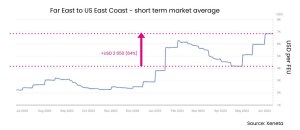US Importers Brace for Freight Rate Surge Amid Strike Threat at East and Gulf Coast Ports
US importers are caught in a vicious cycle of disruption as a looming labor union strike at East and Gulf Coast ports threatens to escalate freight rates and cause massive disruptions in ocean freight container shipping.
Read also: East Coast and Gulf Coast Ports Face Strike Threat as ILA Halts Labor Negotiations

The International Longshoremen’s Association (ILA) recently announced the suspension of labor contract negotiations with the United States Maritime Alliance (USMX). The current agreement is set to expire on September 30, raising fears of a potential strike.
Peter Sand, Chief Analyst at Xeneta, commented, “Shippers have already been frontloading imports ahead of the traditional Q3 peak season due to supply chain concerns from the Red Sea conflict. With the added risk of disruptions at East and Gulf Coast ports, they may accelerate these efforts, further complicating the situation.”
The increased frontloading of imports has contributed to severe port congestion in Asia and Europe, driving ocean freight container shipping spot rates up by more than $2,000 per FEU. Sand noted, “Shippers are stuck in a vicious circle where their efforts to safeguard supply chains could exacerbate the problem.”
According to Xeneta, spot rates from the Far East to the US East Coast have surged by 64% since April 30, reaching $6,820 per FEU as of June 11. In the first four months of this year, 2.44 million 20-foot equivalent units (TEUs) were shipped from the Far East to the US East and Gulf coasts, accounting for over 40% of total US container imports from the region.
Sand suggested that shippers might consider redirecting imports to the US West Coast, reversing a trend seen during the COVID-19 pandemic. However, this shift could tighten capacity and increase rates on the West Coast and other alternatives like Vancouver or Mexico, which has already experienced a significant rise in Far East imports over the past year.
Xeneta’s forward-looking data indicates that the recent surge in spot rates from the Far East to the US East Coast is expected to slow, with a modest 2.4% increase projected for June 15 compared to the 19% rise observed on May 1. Despite this, Sand believes the threat of disruptions could keep spot rates elevated for an extended period.
“If negotiations collapse and more shippers rush to import goods ahead of the holiday season, we could see spot markets remain high,” Sand warned. He also noted the fierce rhetoric from the ILA, which makes the breakdown in negotiations unsurprising.
Well-prepared shippers with robust risk management and supply chain strategies may have anticipated this scenario, contributing to the early frontloading of imports. Sand emphasized that while shippers hope for a resolution similar to last year’s West Coast labor negotiations, a strike amid ongoing pressure on ocean freight networks could lead to a challenging end to 2024.





Leave a Reply